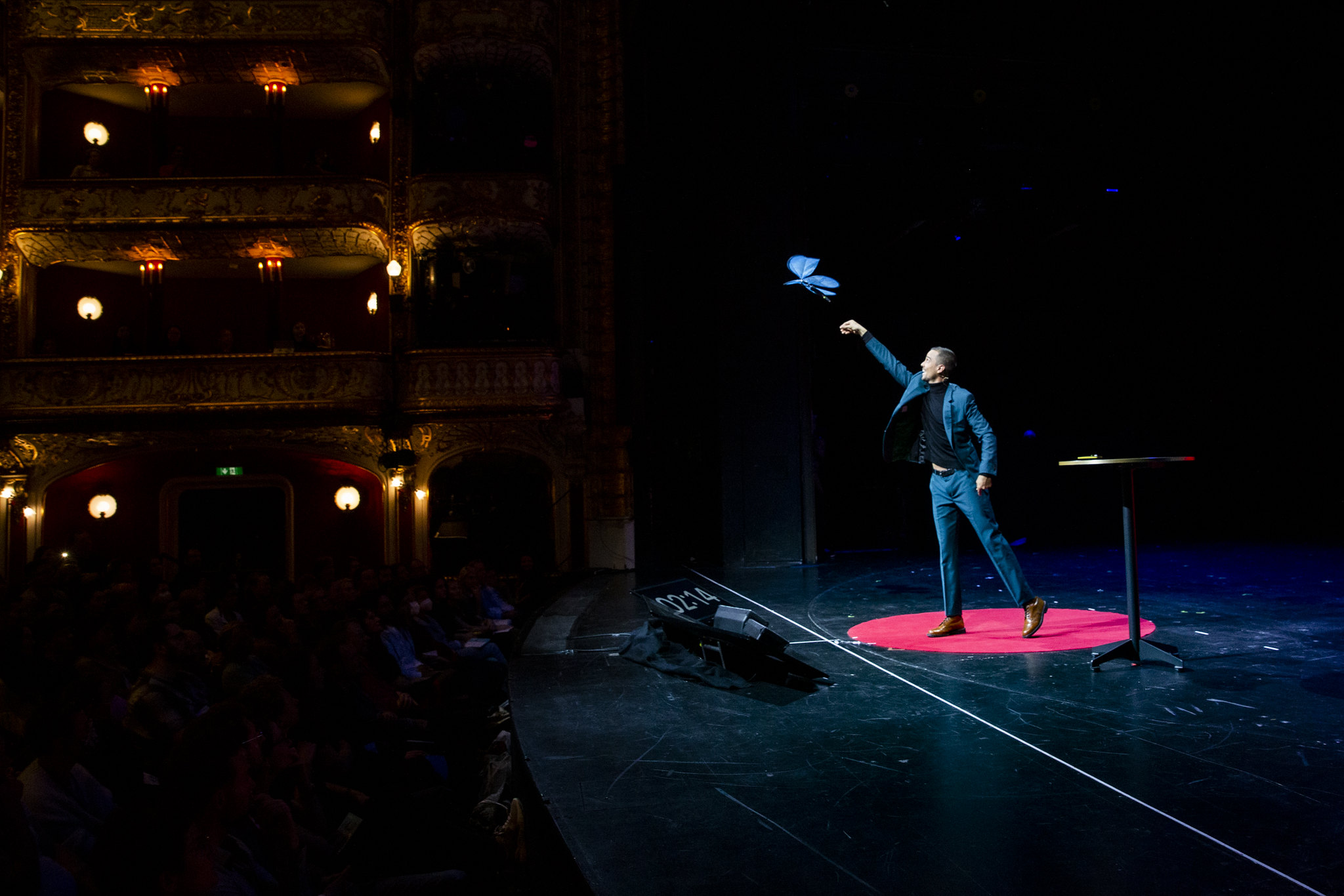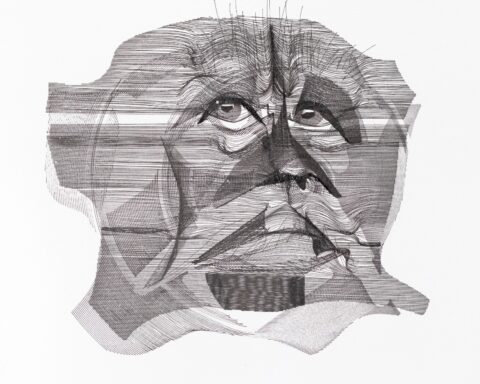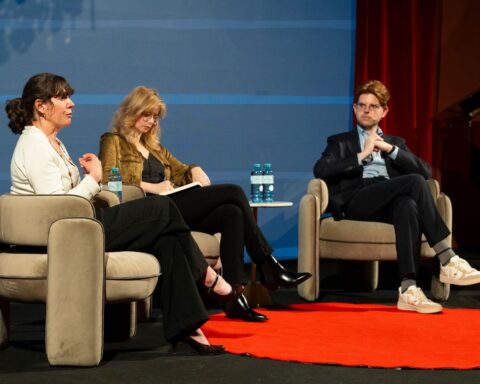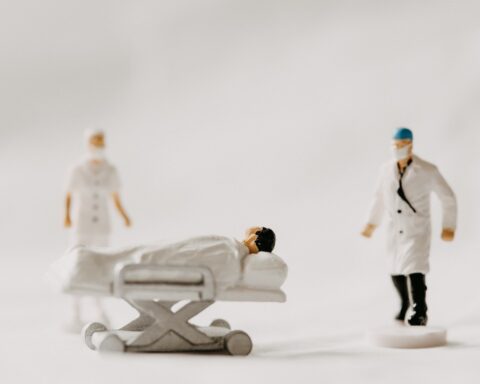Technology surprises us more and more every day with its rapid advancement, sometimes to a point that frightens us. The thought of it one day controlling everything around us is becoming more of a real concern. However, it’s not the technology itself that we should fear, it’s the minds behind it, the controllers.
It was Sebastian Schrof, specialist in robotics and design, who stated this at the beginning of our interview, following his inspiring talk at our TEDx Vienna On the Rise conference. And it was Sebastian who in his talk reminded us of the love we should have for our home, the earth.
Sebastian started his talk off by flying beautiful robotic butterflies overhead, capturing the attention of our audience. The butterflies function as an analogy, how technology can look light, smooth, and beautiful when merged with nature. In his talk Sebastian discusses how we can ally ourselves with technology, combining forces to redirect the way in which carbon dioxide emissions affect our lives. All this by using technology to provide the life-supporting protagonists, algae, with the appropriate environment to absorb carbon dioxide. Sebastian inspired the audience to take care of the planet, to have a sense of belonging, and gave us courage and hope in the face of this problem.
After his talk, I sat down with Sebastian and gained insight into his beginnings, experiences and teachings, and about the incredible project he has been working on.
How would you explain the whole process of carbon dioxide to our readers who may not have heard your talk?
Every day, we consume tons of oil that we take out of the ground. After burning it, the oil creates a lot of carbon dioxide that is released into the atmosphere and causes problems like global warming. So one day the whole atmosphere will be carbon dioxide and we won’t be able to breathe anymore. We need to stop producing carbon dioxide in order to change the actual problem. We are surrounded by a very powerful microorganism called algae. It is a very efficient carbon dioxide saver. We just don’t usually hear about it, because it is in the oceans, we don’t really see it. As a matter of fact, it is a powerful plant, and it is very easy to cultivate just like soil or salad. For algae, you only need water and light. That’s it. Then they start to reproduce themselves and they eat carbon dioxide. Inside algae, there is a lot of carbon dioxide captured from the atmosphere. We could take it and make oil out of it, plastics, or whatever, and this plastic contains carbon dioxide that you took out of the atmosphere. So if you burn it, you only put that amount of carbon dioxide in the atmosphere that you were able to save by growing algae. This way, you have the right circle, and if you make plastic out of it, you keep the carbon dioxide. This way, we can get out of this weird spiral that could kill us. We can improve this big problem just with algae, so simple and more effective than other expensive technological solutions.
How did you come up with the idea of using technology to provide algae with an environment to absorb carbon dioxide?
I used to catch insects as a child and observe them, not as pets, but just for the sake of learning. I always loved scaling down to microsites and wondered how it would be to live near a river, be on a boat and have frogs as friends. After graduating high school, I decided to attend art school. In the process, I discovered that there is a huge gap between technology and empathy. This gap could only be filled by human beings that are able to think like both of the departments. So I began with industrial design in order to create something useful.
Another thought I have always had in my mind was how intimidated I felt thinking about the people in Silicon Valley. They have such huge power just by knowing something other people can’t really comprehend as well as them. I didn’t like the feeling of not being able to change something. After building some robots, I realized how much I was interested in kinematics and mechanics. A few months later, Festo’s head of the bionics department gave a talk at our school. My project inspired them, and they offered me an internship in their department after seeing it. The experience was really rich, I could get in touch with all those engineers, it allowed me to see how much you can do. As a designer, you can set new standards and create new ground. For my diploma thesis, I finally had the freedom to write about what I wanted: ”between industry and insanity” – that’s what I called my thesis. Everybody in the industry uses machines and programming without empathy. The goal is to be more efficient and productive. This is done by working with huge systems, crazy machines, and sometimes robots that may be taller than a house. The theories about technological singularity also explain how computers get smaller every year, as well as faster. Eventually, things will become very intelligent, but we may no longer be able to control them. All this inspired me to collect some plants and bones to make a cabinet of curiosities. This cabinet combines things that aren’t there with things that are already there. That’s how I found my way to the bionics department. Thinking about how to make technology more accessible and not just broader, not more productive and efficient but more human. We shouldn’t be scared of technology itself but the people who are behind it, we should instead encourage people to venture into it and make something good out of it. Not just give the power to a few people to control everyone else.
“As a designer, you can set new standards and create new ground.”
Sebastian Schrof
What has been the greatest experience you have had with nature?
We’ve made a bionic thin wave. It is a swimming robot, we tried to make it as perfect as possible. Kinematics didn’t work as expected, it wasn’t smooth. And then we just made it worse, we made it too loose, so we decided to adjust it and use silicon, a very soft material. On land, it didn’t look right, but we put it in the water, where all the other mediums were completely fluid. I learned If you have the right material you don’t need stiff materials anymore. If you are in water for example, you don’t have to be that precise and forceful all the time. Sometimes you really need to check what nature needs. That’s just the process of life.
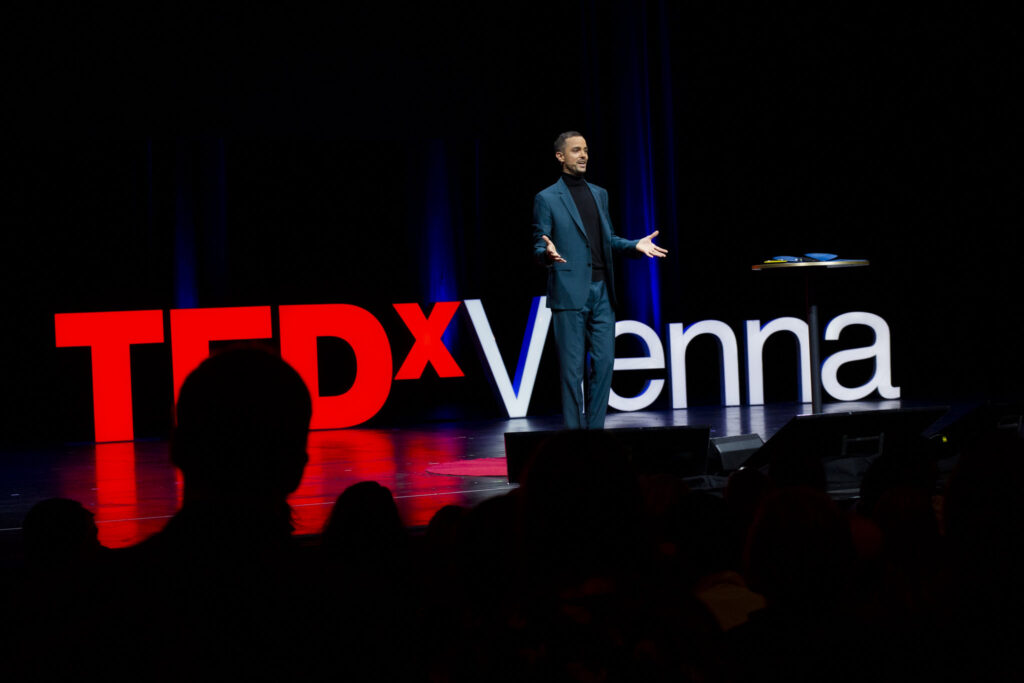
How can people who are not experts in the field help to merge technology and nature?
Starting to think that you as a human being and everything you do and have around you are part of a global network is quite crucial. That way when you step outside and keep this in mind, you won’t throw your garbage on the floor anymore. As a result, you become more conscious, think twice about the food you consume, and become more sensitive to everything. In addition, you begin to recognize the beauty of everything around you. This gives you the feeling of taking action. For example, I started planting seeds that are healthy for bees. It is so easy! And then you get happy about it and you receive a lot of stuff back. I made a bird’s nest for a special bird. That was also technology. Technology doesn’t have to be complex. In other words, even the plants we eat are pieces of technology because they are processed by humans. And all this in our everyday life.
How do you stay hopeful when there are people out there who don’t care about nature or our environment?
Because of organizations like TEDxVienna, because there were so many people, just listening to all those interesting talks. No one talked about profit, even if they could have. The whole day was filled with people who mattered and thought about what could be changed. I work for a very large company and of course they want to make money. They also have to pay a lot of people and want to grow, but they still want to improve the way the industry is run. Some years ago you were just able to convince people by profit but now people are more interested in changing something for the next generation. It is getting more and more relevant for everyone.
“That’s why I don’t lose hope. As long as I can make people interested in it, they will spread it. It’s a big chain”.
Sebastian Schrof.
What is a message you want to share with our readers?
After years of pandemic, economical and ecological depression more or less, this was the first event that showed that we can change the world only with emotions. In the last year, everyone had a home office, was alone at home, and could only gain information through smartphones. However, we still need to speak with our friends and family. I saw it when every speaker stood up on stage and the audience was sparkling with him/her and those emotions can only develop at those kinds of events. The speakers were very serious about what they were saying. Their aim was to share their knowledge, their vision, their ideas, and their inner feelings, and the people were very grateful and welcomed their presence. The whole theater was filled with respect.
Thank you very much Sebastian, you are an inspiring human being who changed my perspective in many ways. During the interview, we also talked a little bit about Sebastian’s son. One thing Sebastian said that stayed with me was
“if you give something to kids, you get something back..That is how the world really works. You give and receive. You don’t necessarily know what it is you get before, but you can always try to give as much as you can, and not just take.”
Sebastian Schrof.
Watch Sebastians full talk at our TEDxVienna On the Rise event below:
Photos by Cherie Hansson, Gabriel Bangura, and Nikita Russ.

